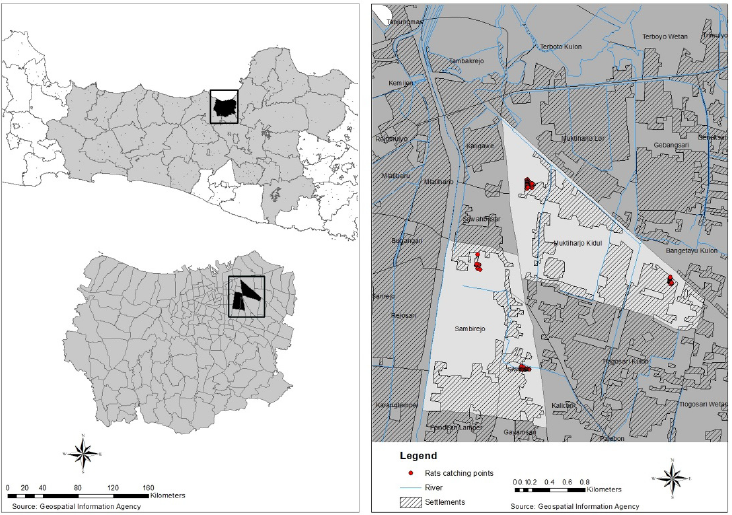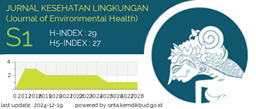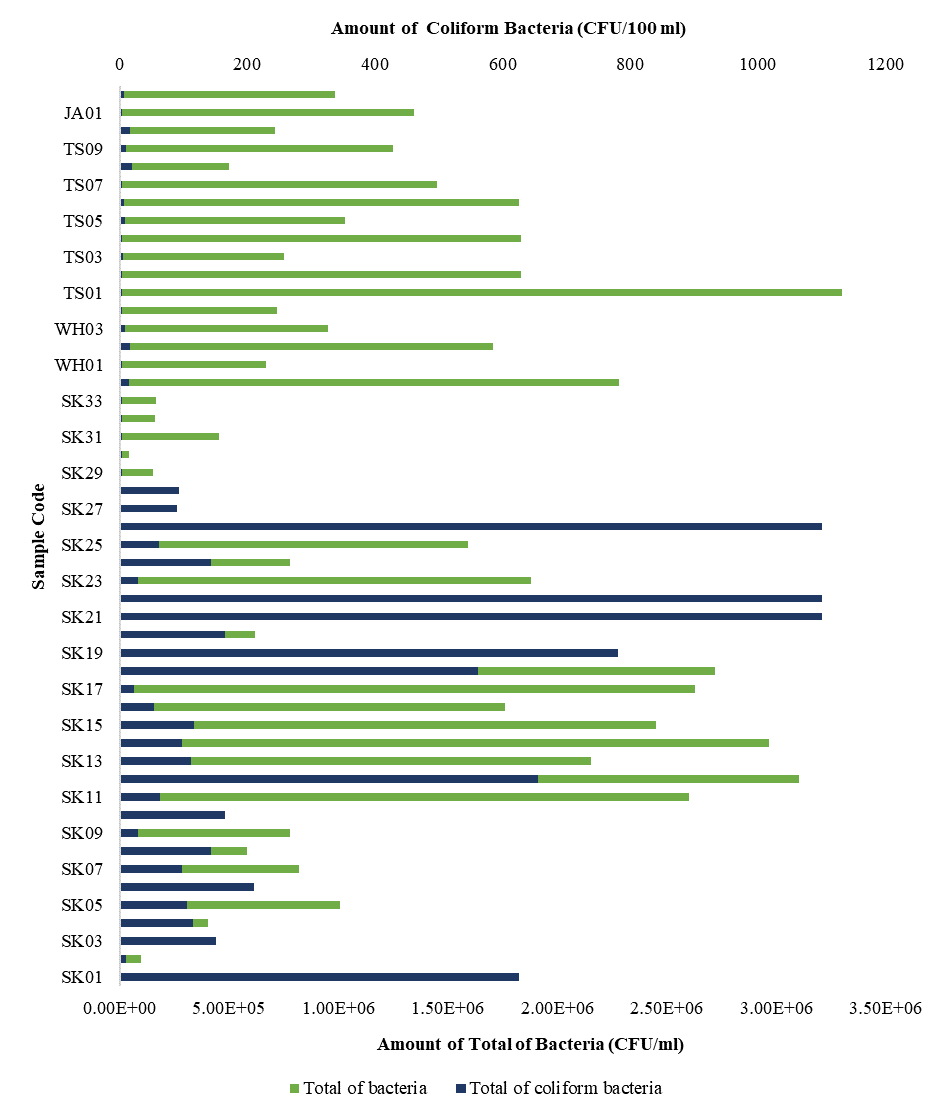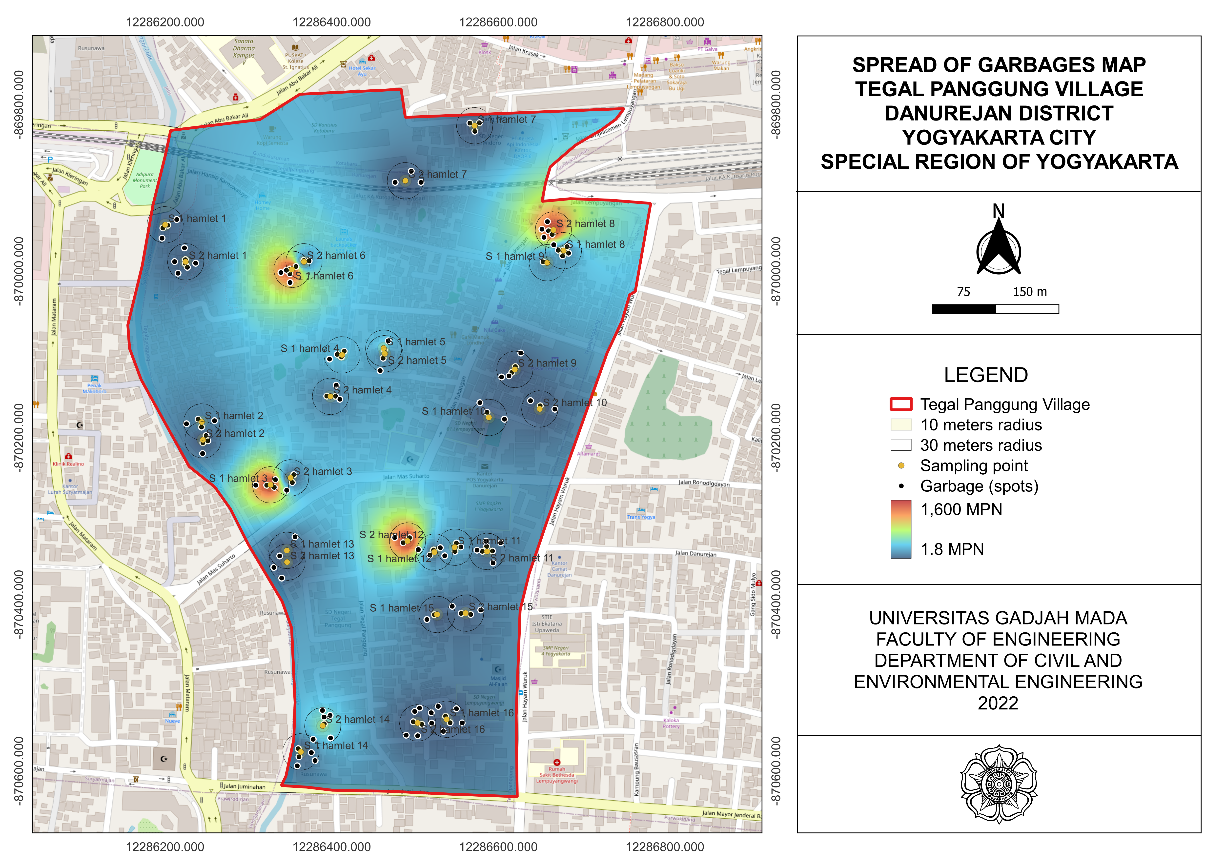Evaluation of Rat Density and the Associated Factors in Leptospirosis Endemic Areas: The First Report on the Use of BI-Index

Introduction: Leptospirosis is a health problem in tropical countries where rats serve as the reservoir of Leptospira contamination. Previous investigations implementing the Bi-index to assess rat density in Leptospirosis endemic areas are highly limited. This study aimed to use the Bi-index in monitoring rat density and the associated factors in urban Leptospirosis endemic areas. Methods: Four endemic areas in Semarang City were selected as the study sites based on Leptospirosis data in Puskesmas Gayamsari. Live traps were positioned in one case house and 39-49 neighboring houses in a 100m radius, on three consecutive days. Trapped rats were collected for species identification, morphometrics evaluation, and calculation of Bi-index and rat indices, while environmental parameters were obtained through observation. Results and Discussion: 67.1% of participants were women, private employees, and aged 17-55, while trap success ranged from 2.5-26.5% with the Bi, diversity, dominance, and evenness indices of 0.02-0.32, 0.94-1.09, 0.36-0.44, and 0.79-0.96, respectively. Trapped species included Rattus norvegicus, Rattus tanezumi, and Mus musculus with proportions of 61.3%, 34.1%, and 4.7%, respectively. The presence of rats was associated with closeness to the river containing stagnant water, frequent flooding, water entering houses during floods, open trash bins, and rubbish bins around the houses. The high rat density, dominant species, and correlated environmental conditions are strategic targets in controlling Leptospirosis in Semarang City. Conclusion: The rat density (dominated by R. norvegicus) in Semarang City was correlated with water drainage and garbage management, hence further investigation was recommended to determine Leptospira bacterial infection in rodents.
Bradley EA, Lockaby G. Leptospirosis and the Environment: A Review and Future Directions. Pathogens. 2023;12(9):1167. https://doi.org/10.3390/pathogens12091167
Rahman ANA, Hadi NHH, Sun Z, Thilakavathy K, Joseph N. Regional Prevalence of Intermediate Leptospira Spp. In Humans: A Meta-analysis. Pathogens. 2021;10(8):1–15. https://doi.org/10.3390/pathogens10080943
Mevada Y, Palkhade R, Chattopadhyay UK, Kanani A, Raj A, Banik A, et al. Serological Survey of Leptospirosis among Poultry Farm and Slaughterhouse Workers and Its Co-relation with the Risk Factors. Int J Curr Microbiol App Sci. 2020;9(9):3556-3571. https://doi.org/10.20546/ijcmas.2020.909.441
Mai LTP, Dung LP, Mai TNP, Hanh NTM, Than PD, Tran VD, et al. Characteristics of Human Leptospirosis in Three Different Geographical and Climatic Zones of Vietnam: A Hospital-based Study. International Journal of Infectious Diseases. 2022;120(1):113–120. https://doi:10.1016/j.ijid.2022.04.011
World Health Organization. Leptospirosis Prevention and Control in Indonesia. Geneva: World Health Organization; 2020. https://www.who.int/indonesia/news/detail/24-08-2020-leptospirosis-prevention-and-control-in-indonesia.
Galan DI, Roess AA, Pereira SVC, Schneider MC. Epidemiology of Human Leptospirosis in Urban and Rural Areas of Brazil, 2000-2015. PLoS One. 2021;16(3):1–20. https://doi:10.1371/journal.pone.0247763
Hakam MA. Health Profile of Semarang City in 2021. Semarang: District Health Office of Sematang; 2022. www.dinkes.semarangkota.go.id
Lunn KF. Leptospirosis in Animals-Overview, Veterinary Manual. United States: MSD Manual Veterinary Manual; 2022. https://www.msdvetmanual.com/generalized-conditions/leptospirosis/leptospirosis-in-animals-overview
Biscornet L, Révillion C, Jégo S, Lagadec E, Gomard Y, Le-Minter G, et al. Predicting the Presence of Leptospires in Rodents from Environmental Indicators Opens Up Opportunities for Environmental Monitoring of Human Leptospirosis. Remote Sens. 2021;13(2):325. https://doi.org/10.3390/rs13020325
Lee MJ, Byers KA, Donovan CM, Patrick DM, Himsworth CG. Is Carriage of Leptospira interrogans by Rats Influenced by the Urban Environment or Population Density? J Wildl Dis. 2021;57(1):157–161. https://doi:10.7589/2019-09-233
Herawati NA, Purnawan T. Effectiveness of Snap Traps on Capturing Rodent and Small Mammals in Rural Area of Two Provinces (Yogyakarta and West Java) in Indonesia. IOP Conf Ser Earth Environ Sci. 2021;913(1):1–10. https://doi:10.1088/1755-1315/913/1/012021
Sunaryo S, Priyanto D. Leptospirosis in Rats and Livestock in Bantul and Gunungkidul District, Yogyakarta, Indonesia. Vet World. 2022;15(6):1449–1455. https://doi:10.14202/vetworld.2022.1449-1455
Rahelinirina S, Bourhy P, Andriamiaramanana F, Garin B, Rajerison M. High Prevalence of Leptospira spp. in Rodents in An Urban Setting in Madagascar. American Journal of Tropical Medicine and Hygiene. 2019;100(5):1079–1081. https://doi:10.4269/ajtmh.18-0642
Byers KA, Lee MJ, Patrick DM, Himsworth CG. Rats About Town: A Systematic Review of Rat Movement in Urban Ecosystems. Front. Ecol. Evol. 2019;7(13):1-12. https://doi:10.3389/fevo.2019.00013
Mohd-Taib FS, Ishak SN, Yusof MA, Azhari NN, Md-Lasim A, Md Nor S, et al. Leptospirosis: An Insight into Community Structure of Small Mammal’s Host in Urban Environment. Trop Biomed. 2020;37(1):142–154. https://pubmed.ncbi.nlm.nih.gov/33612725/
Susanna D, Nova RIT, Rozek L. The Existence and Characteristics of Rats and Shrews in Endemic Leptospirosis Areas and Types of Ectoparasites: A Case Study of West Jakarta, Indonesia. F1000Res. 2021;10(335):1–13. https://doi:10.12688/f1000research.47068.1
Hestiningsih R, Daniswara S, Kusariana N, Martini M, Yuliawati S, Mawarni A, et al. Population of Rodent and Leptospirosis in Humans: Spatial Aspect of Epidemiology. Journal of Communicable Diseases. 2023;55(1):45–50. https://doi:10.24321/0019.5138.202307
Herbreteau V, Gonzalez JP, Andrianasolo H, Kittayapong P, Hugot JP. Mapping the Potential Distribution of Bandicota indica, Vector of Zoonoses in Thailand, by Use of Remote Sensing and Geographic Information Systems (a Case of Nakhon Pathom Province). The Natural History Journal of Chulalongkorn University. 2005;5(2):61–67. https://www.thaiscience.info/journals/Article/NHCU/10439743.pdf
Baharom M, Ahmad N, Hod R, Ja’afar MH, Arsad FS, Tangang F, et al. Environmental and Occupational Factors Associated with Leptospirosis: A Systematic Review. Heliyon. 2024;10(1):23473. https://doi:10.1016/j.heliyon.2023.e23473
Emmanuel EL. Factors Contributing to the Occurrence of Leptospirosis, and the Impact on Public Health in Saint Lucia 2008-2019. Texila International Journal of Public Health. 2020;8(4):1-10. https://doi:10.21522/TIJPH.2013.08.04.Art008
Dewi PS, Rahardjo SS, Murti B. Analysis of Environmental Risk Factors on the Leptospirosis Disease in Klaten, Central Java, Indonesia. Journal of Epidemiology and Public Health [Internet]. 2020;5(2):158–167. http://orcid.org/0000-0001-9405-3872
Handayani DF. Karakteristik Genomik Dan Epidemiologi Pes, Leptospirosis, Rickettsiosis, Dan Hantavirus. Salatiga: Lembaga Penerbit Badan Penelitian dan Pengembangan Kesehatan; 2023.
Jeffree MS, Mori D, Yusof NA, Atil A Bin, Lukman KA, Othman R, et al. High Incidence of Asymptomatic Leptospirosis among Urban Sanitation Workers from Kota Kinabalu, Sabah, Malaysian Borneo. Sci Rep. 2020;10(1):3–8. https://doi:10.1038/s41598-020-76595-0
Parra-Barrera EL, Bello Piruccini S, Rodríguez K, Duarte C, Torres M, Undurraga EA. Demographic and Clinical Risk Factors Associated with Severity of Lab-confirmed Human Leptospirosis in Colombia, 2015–2020. PLoS Negl Trop Dis. 2023;17(7): e0011454. https://doi.org/10.1371/journal.pntd.0011454
Notobroto HB, Mirasa YA, Rahman FS. Sociodemographic, Behavioral, and Environmental Factors Associated with the Incidence of Leptospirosis in Highlands of Ponorogo Regency, Province of East Java, Indonesia. Clin Epidemiol Glob Health. 2021;12(1):100911. https://doi.org/10.1016/j.cegh.2021.100911
López-Robles G, Córdova-Robles FN, Sandoval-Petris E, Montalvo-Corral M. Leptospirosis at Human-animal-environment Interfaces in Latin-America: Drivers, Prevention, and Control Measures. Biotecnia. 2021;23(3):89-100. https://doi.org/10.18633/biotecnia.v23i3.1442
Setyaningsih Y, Kartini A, Bahtiar N, Pradigdo SF, Saraswati L. Presence of Leptospira sp. and Leptospirosis Risk Factor Analysis in Boyolali District, Indonesia. J Public Health Res. 2022;11(1):2144. https://doi.org/10.4081/jphr.2021.2144
Flores B, Sheleby-Elias J, Pérez-Sánchez T, Fischer R, Múzquiz J, Fuertes H, et al. Leptospira spp in Rodents from Peridomestic Sites in Endemic Regions of Nicaragua. Ecohealth. 2020;17(4):469–476. https://doi.org/10.1007/s10393-021-01520-4
Anwar RM, Manyullei S, Sjahril R, Daud A, Mallongi A, Hidayanty H. Relationship of the Environmental Condition with the Presence of Leptospira in Rats in Flood Prone Areas in Makassar City. Saudi Journal of Nursing and Health Care. 2020;3(8):228–233. http://dx.doi.org/10.36348/sjnhc.2020.v03i08.001
Handayani FH. Buku Leptospirosis. Jakarta: Balitbangkes; 2019.
Pascual J, Franco S, Bueno-Marí R, Peracho V, Montalvo T. Demography and Ecology of Norway Rats, Rattus norvegicus, in the Sewer System of Barcelona (Catalonia, Spain). J Pest Sci. 2020;93(2):711–722. https://doi.org/10.1007/s10340-019-01178-6
Zeppelini CG, Carvalho-Pereira T, Sady Alves & R, Santiago DCC, Santo VFE, Begon & M, et al. Demographic Drivers of Norway Rat Populations from Urban Slums in Brazil. Urban Ecosystem. 2021;24:801–809. https://doi.org/10.1007/s11252-020-01075-2
Friscia AR, Helman S, Maloney M, Molina-Echavarria AK, Nugen S, Punjabi N, et al. Live-trapping of Rodents in Urban Green Spaces across Los Angeles. BioOne. 2023;122(2):122–130. https://doi.org/10.3160/0038-3872-122.2.122
Sholichah Z, Ikawati B, Marbawati D, Khoeri MM, Ningsih DP. The Role of Rattus norvegicus from Rat and Suncus Group as The Main Transmitter of Leptospira in Semarang. Journal of Disease Vector. 2021;15(1):53–62. http://dx.doi.org/10.22435/vektorp.v15i1.2607
Ding F, Guo XG, Song WY, Fan R, Zhao CF, Mao KY, et al. Infestation and Distribution of Chigger Mites on Brown Rat (Rattus norvegicus) in Yunnan Province, Southwest China. Trop Biomed. 2021;38(1):111–121. https://doi.org/10.47665/tb.38.1.020
Ristiyanto, Handayani FD, Boewono DT, Heriyanto B. Penyakit Tular Rodensia. Yogyakarta: Gadjah Mada University Press; 2014.
Gurbanov R, Kabaoğlu U, Yağcı T. Metagenomic Analysis of Intestinal Microbiota in Wild Rats Living in Urban and Rural Habitats. Folia Microbiol (Praha). 2022;67(3):469–477. https://doi.org/10.1007/s12223-022-00951-y
Hosseini SH, Moradi HV. Morphological and Morphometric Characteristics of Brown Rat (Rattus Norvegicus) in Tehran and Mashhad. Journal of Animal Environment. 2020;12(4):171-178. https://doi.org/10.22034/aej.2020.125402
Islam MM, Farag E, Mahmoudi A, Hassan MM, Atta M, Mostafavi E, et al. Morphometric Study of Mus musculus, Rattus norvegicus, and Rattus rattus in Qatar. Animals. 2021;11(8):1–15. https://doi.org/10.3390/ani11082162
Alexander M, Stuart GRSJJ. CABI Compendium. 2016. Rattus tanezumi (Asian House Rat). https://doi.org/10.1079/cabicompendium.66732
Rachmawati I, Adi MS, Nurjazuli N. Literature Review: Environmental Risk Factors of Leptospirosis in Indonesia. Poltekita : Jurnal Ilmu Kesehatan. 2023;16(4):505–512. https://doi.org/10.33860/jik.v16i4.1230
Kipper BH, Stein CE, Castro THS, daSilva BC, Baumgartel C, Pereira K, et al. Evaluation of the Level of Knowledge of the Population and Risk Factors Related to Leptospirosis in an Endemic City. Int Arch Public Health Community Med. 2020;4(1):34. https://doi.org/10.23937/2643-4512/1710034
Hinjoy S, Kongyu S, Doung-Ngern P, Doungchawee G, Colombe SD, Tsukayama R, et al. Environmental and Behavioral Risk Factors for Severe Leptospirosis in Thailand. Trop Med Infect Dis. 2019;4(2):1–12. https://doi.org/10.3390/tropicalmed4020079
Teles AJ, Bohm BC, Silva SCM, Bruhn FRP. Socio-geographical Factors and Vulnerability to Leptospirosis in South Brazil. BMC Public Health. 2023;23(1):1–12. https://doi.org/10.1186/s12889-023-16094-9
Miller E, Barragan V, Chiriboga J, Weddell C, Luna L, Jiménez DJ, et al. Leptospira in River and Soil in A Highly Endemic Area of Ecuador. BMC Microbiol. 2021;21(1):1–11. https://doi.org/10.1186/s12866-020-02069-y

This work is licensed under a Creative Commons Attribution-NonCommercial-ShareAlike 4.0 International License.
1. Copyright of all journal manuscripts is held by the Jurnal Kesehatan Lingkungan.2. Formal legal provisions to access digital articles of electronic journal are subject to the provision of the Creative Commons Attribution-ShareAlike license (CC BY-NC-SA), which means that Jurnal Kesehatan Lingkungan is rightful to keep, transfer media/format, manage in the form of databases, maintain, and publish articles.
3. Published manuscripts both printed and electronic are open access for educational, research, and library purposes. Additionally, the editorial board is not responsible for any violations of copyright law.
JKESLING by UNAIR is licensed under a Creative Commons Attribution-ShareAlike 4.0 International License.







































